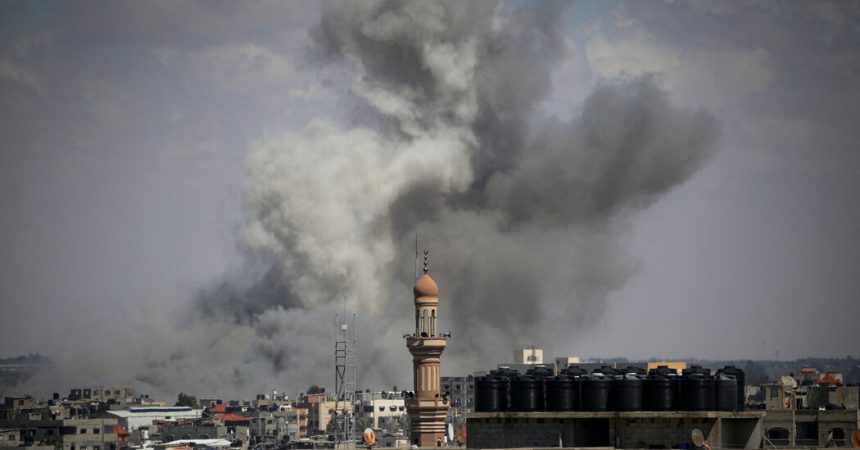Over the course of a few hours, the news from the Middle East came into the White House Situation Room fast and furious.
Israel orders 100,000 civilians out of Rafah in prelude to invasion.
Hamas “accepts” cease-fire deal, potentially precluding invasion.
Israel conducts strikes against Rafah, possibly opening invasion.
The war-is-on-off-on-again developments on Monday left White House officials scrambling to track what was happening and what it all meant. At the end of the day, they came to believe, each of the moves signaled less than originally met the eye, but reflected efforts to gain leverage at the negotiating table with a clear resolution not yet in sight.
In fact, Hamas did not “accept” a cease-fire deal so much as make a counteroffer to the proposal on the table previously blessed by the United States and Israel — a counteroffer that was not itself deemed acceptable but a sign of progress. At the same time, Israel’s strikes in Rafah evidently were not the start of the long-threatened major operation but targeted retaliation for Hamas rocket attacks that killed four Israeli soldiers over the weekend — and along with the warning to civilians, a way to increase pressure on Hamas negotiators.
The flurry of actions underscored how fluid the situation in the region is as President Biden and his team try to broker a deal that they hope will ultimately end the war that has devastated Gaza, killed tens of thousands of combatants and civilians, inflamed the region and provoked unrest on American college campuses. Over the last few days, the talks went from high hopes that a deal was close, to a fresh impasse that seemed to leave them on the verge of collapse, to a renewed initiative by Hamas to get them back on track.
“Biden is continuing all efforts to thread multiple needles at once,” said Mara Rudman, a former deputy Middle East special envoy under President Barack Obama who is now at the University of Virginia’s Miller Center. The president is still warning Prime Minister Benjamin Netanyahu of Israel that a “Rafah ground invasion is a terrible idea,” she said, while also “pressuring Hamas in every way possible to get hostages out and more humanitarian aid in.”
Mr. Biden called Mr. Netanyahu on Monday to fill him in on the American assessment of where the cease-fire talks stand and to again press the Israeli leader to hold off any full-fledged attack on Rafah. The president also hosted lunch at the White House with King Abdullah II of Jordan, who like other Arab leaders is eager to bring the war to an end.
The past two weeks have been as intense and suspenseful diplomatically as any since Hamas mounted a major terrorist attack on Israel on Oct. 7, killing an estimated 1,200 people and taking more than 200 hostages. After months of stalemated talks, Israel came back on April 26 with a proposal that American officials believed changed the dynamics and offered a serious chance for agreement.
Under the first phase of the proposal, Israel would halt the war for 42 days and release hundreds of Palestinians held in its prisons while Hamas would release 33 hostages, specifically women, older men and the sick and wounded.
The number 33 was an increase from 18 proposed by Hamas but lower than the 40 originally demanded by Israel, in large part because Israeli officials came to understand that there were not more than 33 hostages who met the criteria, according to people informed about the discussions who insisted on anonymity to describe sensitive talks. Indeed, Hamas revealed to the Israelis on Monday that the 33 would include the remains of hostages who have died as well as those still living.
In addition, Israel would pull its forces out of populated areas of Gaza and permit Gazans to return to the northern part of the enclave once conditions were met; to that end, the cease-fire would enable a large increase in the flow of humanitarian aid. In trying to call Hamas’s bluff, the people informed on the talks said, the Israelis virtually cut and pasted some of the language from a Hamas proposal in March and put it into theirs.
During the six-week cease-fire, the two sides would then work out plans for a second phase, which would involve another 42-day halt to hostilities and the release of more hostages. In this phase, the hostages to be released would include Israeli soldiers, a category of captives that Hamas has always been more resistant to giving up. To get over that hurdle, the Israelis agreed to release a larger ratio of Palestinian prisoners for each hostage returned home.
The Israeli concessions left American, Egyptian and Qatari intermediaries optimistic that an agreement could be reached. But a week went by without a clear response from Hamas, in part perhaps because of the challenges of communicating with Yahya Sinwar, the Hamas military leader believed to be hiding in the tunnels of Gaza.
When negotiators arrived in Cairo on Friday, the Israelis did not send a delegation, which was interpreted by some critics of Mr. Netanyahu as a snub. But Israeli and American officials denied that, saying that no Israeli delegation was needed at that stage because Israel had made its proposal and was waiting for a Hamas response.
Hamas’s response over the weekend frustrated the intermediaries because it rejected some of the very language that it had previously proposed and that had been adopted by the Israelis, according to the people briefed on the talks. The American side declared the new Hamas position unacceptable, and suggested that if Hamas did not really want a deal, perhaps the negotiations were done. But Hamas indicated that it was not trying to torpedo the talks and would come back with a new version.
That was the counteroffer that Hamas forwarded on Monday. The Israelis and Americans did not find it acceptable, but believed that it left room for further negotiations. Talks are expected to resume in Cairo at a technical level, probably on Wednesday, to go through the details. This time, Israel has agreed to send a delegation to go over the Hamas counteroffer.
The Israeli actions in Rafah on Monday could either ratchet up the pressure on Hamas to make a deal or sabotage the talks, according to analysts. The strikes focused on targets in the border areas of Rafah, rather than the main population areas, but could foreshadow what is to come.
It was not entirely clear to veterans of the region whether either side necessarily wants an agreement. Jon B. Alterman, the director of the Middle East program at the Center for Strategic and International Studies in Washington, said it was possible that Hamas thought that “precipitating a massive Israeli operation in Rafah would be worth the cost, because it would isolate Israel globally and deepen the U.S.-Israel divide.”
At the same time, he said, it could be that Mr. Netanyahu is “seeking a trifecta” with the strikes on Monday: pushing Hamas to give in, showing the Israeli public that he did hit Rafah as promised and getting credit from the Biden administration for not mounting the full-scale assault that Washington fears would result in a civilian catastrophe.
“There are secrets here I just don’t know,” Mr. Alterman said. “At the same time, no side knows the others’ breaking point, and I worry that no side accurately understands the others’ assessments.”
Khaled Elgindy, a senior fellow at the Middle East Institute and former adviser to Palestinian leaders during past peace negotiations, said he remained skeptical that Mr. Netanyahu actually wanted a cease-fire deal because of his own domestic politics.
“I don’t believe moves on or in Rafah, including evacuation orders, are just a negotiating tactic,” he said. “Netanyahu needs the Rafah operation to remain in power and to appease the fanatics in his coalition.” He added, “Bottom line, Netanyahu has little to gain from a cease-fire deal and a lot to lose.”
That distrust on both sides, of course, makes any agreement all the more elusive. While the two sides seem reconciled on the first phase cease-fire and hostage release, there are still a number of other differences between the two competing proposals, according to the people briefed on them. But the most fundamental dispute is whether an agreement would ultimately end the war.
Negotiators have tried to finesse that with a time-honored diplomatic tactic of employing language that is vague enough to be interpreted by each side as it chooses. Under the agreement, the two sides would use the temporary cease-fire to work out the return of “sustainable calm.” Hamas wants “sustainable calm” to mean a permanent cessation of hostilities, while Israel does not want to make that explicit a commitment.
American officials are content to leave the definition of “sustainable calm” a little fuzzy, but are banking on the idea that once the guns stop firing for six and then potentially 12 weeks, the momentum for a more lasting peace will be inexorable. That is why they are devoting so much energy to the coming days.






